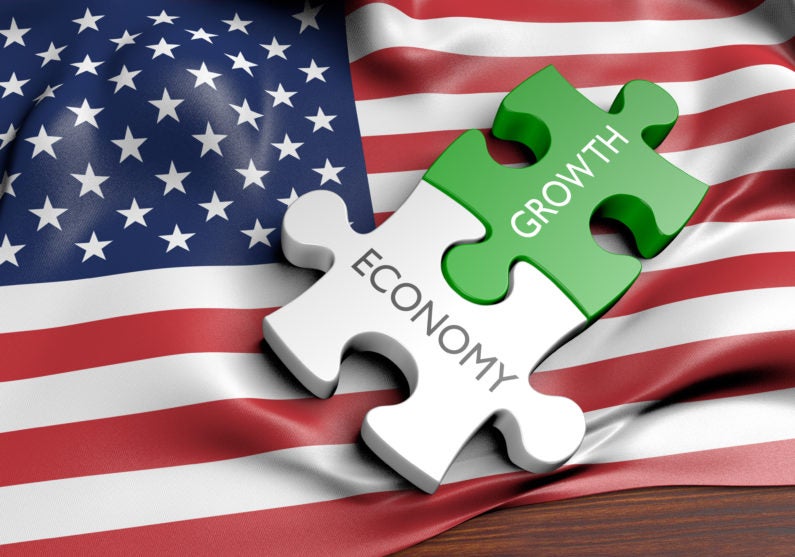U.S. economy’s anticipated boom following the Great Recession derailed by long-simmering factors, Stanford economist says
Stanford economist Robert Hall explored why the U.S. economy – since 2009 – has not experienced impressive growth, an effect that usually follows recessions. He finds the roots of the economy’s slow growth existed well before the financial crisis.
The U.S. economy historically tends to thrive after a recession with gross domestic product (GDP) annual growth rates rising above 4, 5 and even 7 percent.

The U.S. economy’s slow recovery is rooted in factors that existed well before the Great Recession, according to Stanford economist Robert Hall. (Image credit: Kagenmi / Getty Images)
That hasn’t been the case since the Great Recession. While the economy has experienced growth in every year since 2009, the rise has been unspectacular. (The highest rate of GDP growth since the financial crisis was 2.6 percent in 2015.)
So why has the economy not rebounded as it has in the past? A working paper co-authored by Robert Hall, a senior fellow at the Hoover Institution and a professor of economics at Stanford, provides a unique perspective to the debate. His research identifies two factors that explain the economy’s slow growth – and both were in play well before the financial crisis and recession struck.
Stanford News Service interviewed Hall about his findings.
What does your research identify as the major causes for the lackluster rate of growth output since 2009?
We found that the two most important channels of poor output growth were low productivity growth and shrinkage of the labor force. We would not call these “causes” because they are economic responses to more fundamental forces, but we were more successful in disposing of explanations than we were in finding these forces.
Some argue that government regulations and weak investment, among other factors, are to blame for slow growth. Did they indeed have a negative effect?
We worked on trying to quantify the changes in regulations and their effects on productivity, but did not confirm much of a connection. We showed that weak investment did not appear to be an independent force explaining weak growth, but rather a response to the adverse forces of low productivity growth and shrinking labor force. The primary evidence is that the capital/output ratio rose at least at its normal rate during the recovery.
Your research touches on economic forecasts being largely inaccurate in predicting growth post-recession. Why was it so difficult to accurately predict economic growth during this period?
It’s always hard to forecast the economy more than a few months into the future, just like we can’t forecast the weather more than five days in advance. There was nothing special about forecasting errors during the recovery – we always make huge errors. The business cycle is inherently unforecastable.
Some attribute the decline in the labor force to the retirement of baby boomers. Were there other factors in play that led to the decline?
We show that between one-half and two-thirds of the shrinkage of the labor force was due to the changing demographic mix of the working-age population. We are not so sure about other factors. Rising dependence on disability benefits is one factor, though not nearly large enough to explain what has happened.
Your research states a slowdown in total factor productivity (TFP) growth occurred around 2006 – before the recession. Why was TFP slowed in the mid-2000s?
Our take is that the second half of the 1990s and the first half of the 2000s were a special, unsustainable period of productivity growth, possibly because of the adoption of information technology. We can’t rule out the possibility that productivity will continue to grow at lower than historical rates, but many surprises have occurred in the past in productivity growth – it’s as hard to predict as any other feature of the economy.
Can some of the proposed initiatives touted by the Trump administration (overhauling tax code, infrastructure investment, etc.) make a positive impact on short-term growth or would the benefits of these programs not be seen for years?
Our paper did not focus on that topic. My personal belief is that tax reform and regulatory reform, such as rolling back the tide of occupational licensing restrictions, would have payoffs at least in the intermediate future. Our biggest need is to improve K-12 education, but the scope of federal reform in that area is small.
You and your colleagues don’t seem optimistic about increased growth. Will growth pick up in the future or slow further?
See above. Qué será, será.
Hall is a senior fellow at the Hoover Institution and the Robert and Carole McNeil Professor of Economics. His working paper, “The Disappointing Recovery of Output after 2009,” is co-authored by John Fernald of the Federal Reserve Bank of San Francisco, James Stock of Harvard University and Mark Watson of Princeton University.
